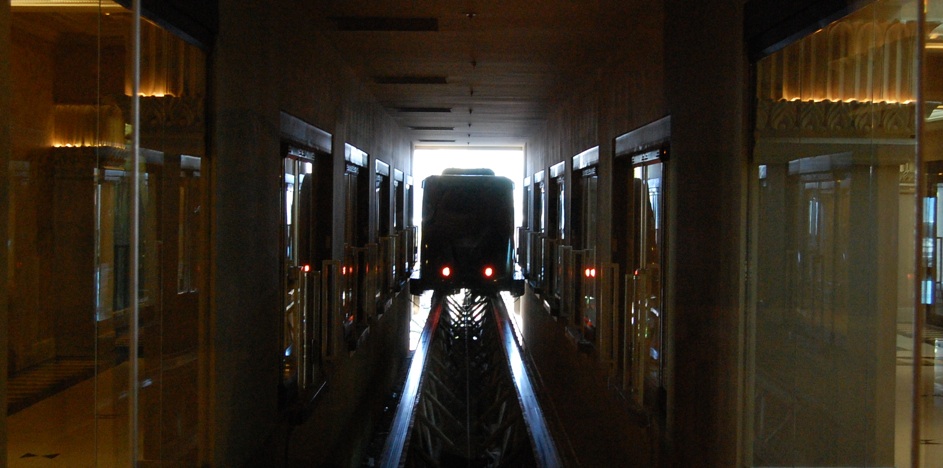I recently travelled to Las Vegas, Nevada to explore that city’s two public cable systems. This is Part 1 of a 3 Part report on the Mandalay Bay Cable Car.
In the late 1990’s, the MGM group wanted to build a new casino in Las Vegas. The new casino – dubbed The Mandalay Bay – would be MGM’s sprawling take on a tropical paradise with far less emphasis on the kitsch the company had become associated with. The Mandalay Bay was not to be another Luxor or Excalibur.
Virtually all of MGM’s resort holdings in Las Vegas are located in one cluster at the interesection of Tropicana and Las Vegas Blvd. On the north-east corner is the MGM Grand. On the north-west is the New York, New York and the Monte Carlo. On the south-west corner is the Excalibur and Luxor. The Mandalay Bay was to be located south of the Luxor, one kilometer away from Tropicana and Las Vegas Blvd, much too far away from the action.
This presented a problem to MGM executives. A walk from the Grand, New York New York or, really, any of the MGM resorts would simply take too long. The friction of distance would either limit tourists’ spending or they would simply avoid Mandalay Bay entirely.
Movement is hard in Las Vegas. Intentionally so. The more people are walking around, the less they’re spending money. The casinos and resorts are designed in such a way that once you’re in, it’s very hard to get out. Exits are rare and placed as far away from suites as possible. It’s an exercise in social control where conspicuous consumption is the desired outcome.
The solution needed to be a short, high-speed transit link. The link had to be cheap, easy to maintain, available 24 hours a day, open to the general public and – most importantly – free of charge.
The answer was an elevated cable car system designed and manufactured by Doppelmayr. Completed in 1999, it was the first bottom-supported cable system by the Austrian cable transit giant behind such installations as the Peak 2 Peak and the Galzigbahn. Doppelmayr had little experience in bottom-supported systems other than funiculars and this presented a whole new set of challenges.
Built for a total cost of $26 million (1999 US), the Mandalay Bay cable car was remarkably cost-effective. The system and guideway itself only cost $16 million while the four integrated stations made up the rest of the total investment.
This was a very inexpensive system to build considering its capabilities (to be discussed tomorrow). While I have no evidence to support the following claim, I reason that the cost of the system had as much to do with the manufacturer’s desire to penetrate the urban people mover market as it did with the cost-effectiveness of the technology. Nevertheless, cost-savings accrued due to one major innovation:
Unlike previous Las Vegas cable propelled systems at Circus Circus and the Mirage, the Mandalay Bay system would utilize a modular steel truss guideway. This guideway – which could be manufactured off-site in a controlled environment – was cheaper to build than traditional concrete guideways that were far more typical of the time. Even today, concrete guideways are standard on almost all self-propelled people mover systems due to load-bearing requirements.

The Mandalay Bay Cable Car connects three MGM properties: The Mandalay Bay, Luxor and Excalibur. Image by Steven Dale.
The steel guideway also had the added benefits of less aesthetic intrusion on the urban environment and the ability to transmit light to the the areas below it. It had not, however, been demonstrated in a cable system to date except in a demo site at one of Doppelmayr’s manufacturing facilities.
Despite having no track record to speak of, the guideway was a tremendous breakthrough and is now standard on almost every Doppelmayr bottom-supported system.
Tomorrow in Part 2 of this report, I’ll discuss the capabilities of the Mandalay Bay system and some of its finer and unique qualities.



2 Comments